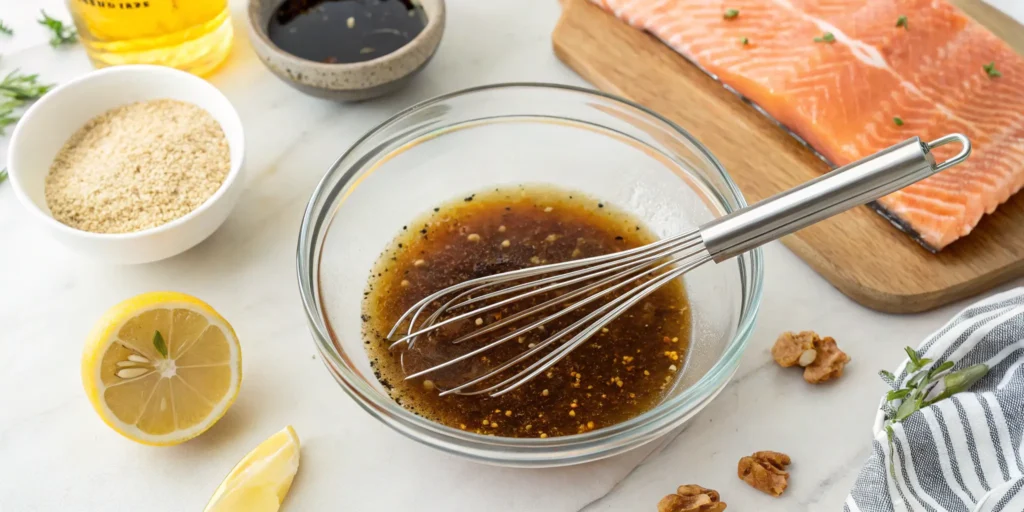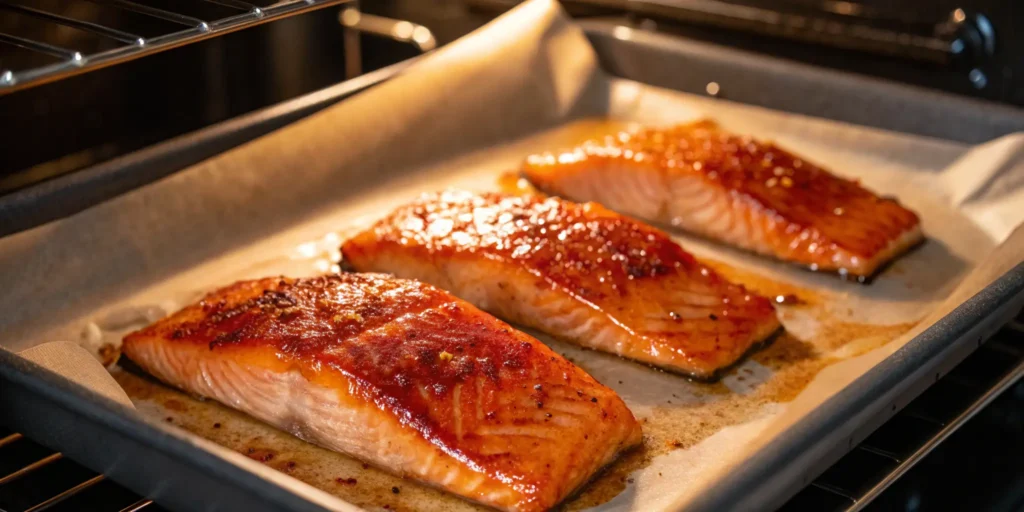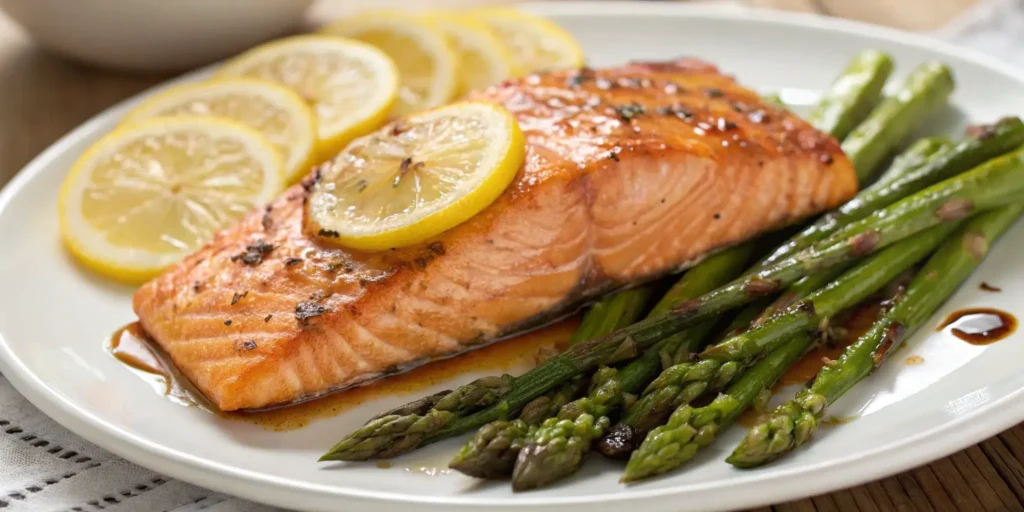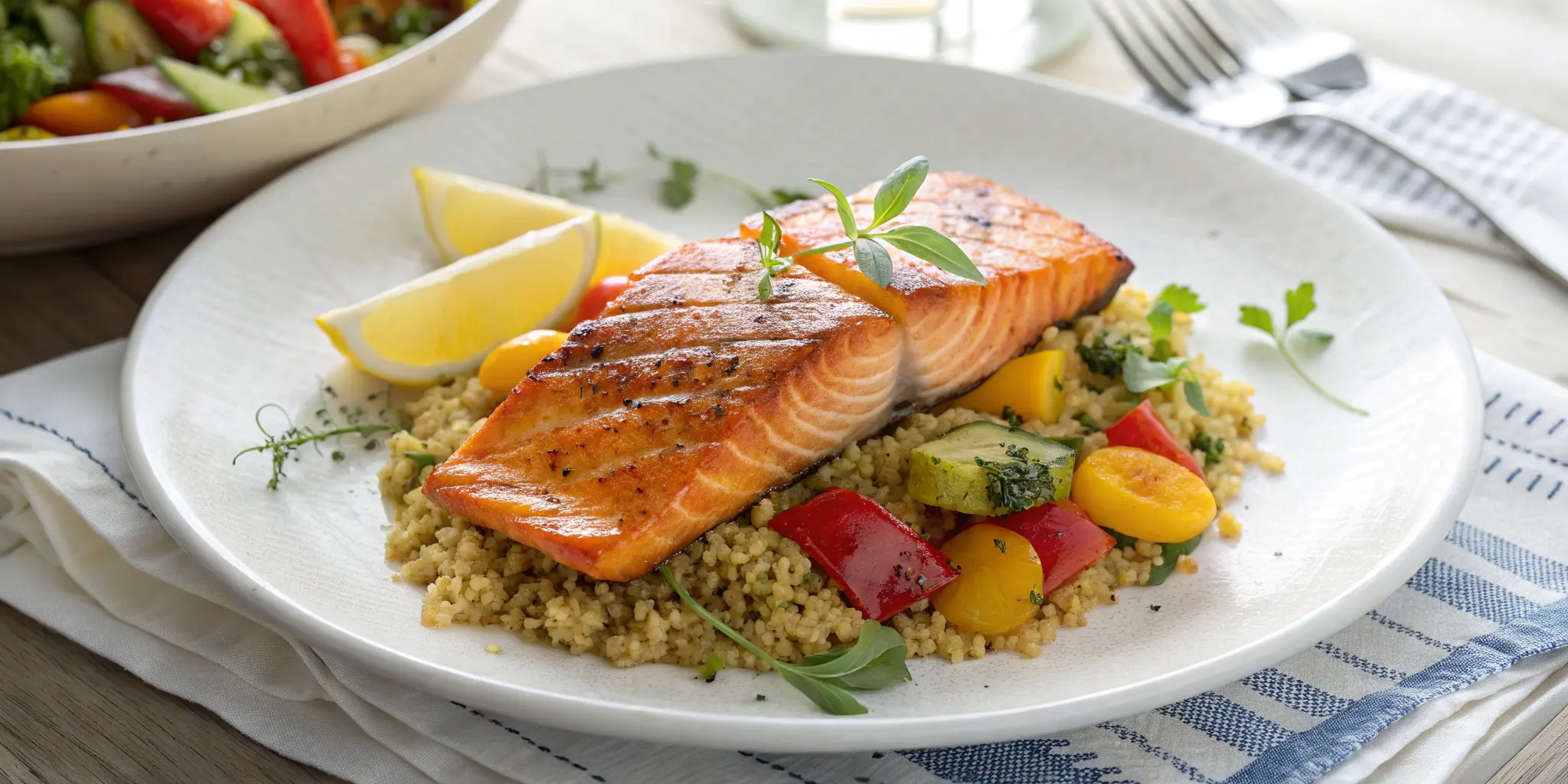Maple Glazed Salmon: 7 Easy Steps for Perfect Flavor Boost
Table of Contents
Why Maple Glazed Salmon is More Than Just a Dish
You’ve likely stood in your kitchen, wondering what to cook that feels special without being complicated. Maybe you’re craving something with depth—a balance between sweet and savory that doesn’t take hours of prep. That’s where maple glazed salmon steps in. It’s more than just a meal—it’s a flavor experience that brings warmth and satisfaction in every bite.
Whether you’re aiming to impress dinner guests or simply treat yourself to something extraordinary on a weeknight, this dish delivers every time. The natural sweetness of maple syrup, paired with the richness of salmon, creates a comforting yet elevated dish that feels both rustic and refined.
If you’ve ever struggled to bring bold, balanced flavor to your fish dishes, you’re not alone. Many recipes fall flat, lacking that one thing that ties everything together. But with maple glazed salmon, the glaze does more than coat—it penetrates, caramelizes, and brings out the natural richness of the fish.
This guide walks you through seven easy steps to bring out the perfect flavor in your maple glazed salmon. From choosing the right cut of salmon to mastering the glaze and plating like a pro, every step is designed to make the process smooth and the results unforgettable.
Ready to dive in? Let’s start with the foundation of any great dish: the ingredients.
Step 1 – Choosing the Best Salmon for Glazing
When you want your maple glazed salmon to taste exceptional, it all begins with the right piece of fish. The glaze will only enhance what’s already there—so if the salmon is lacking in quality or freshness, no amount of maple syrup will save it. That’s why selecting the right type of salmon is step one.
Which Salmon is Best for Maple Glazed Salmon?
Not all salmon is created equal. If you’ve ever wondered why some salmon turns out moist and flavorful while others end up dry or bland, it usually comes down to the species and the source.
Here’s what to look for:
- Wild-Caught Salmon: This is your top choice. Wild salmon varieties like Sockeye or King (Chinook) have firmer flesh and deeper flavor that holds up beautifully under a sweet, sticky glaze.
- Farmed Salmon: This can still work, especially if it’s responsibly raised. Farmed salmon tends to be milder and fattier, which pairs nicely with bold glazes like maple mustard or maple soy.
Skin-On vs. Skinless Fillets
You might be tempted to go with skinless fillets, thinking they’ll cook faster or look neater. But keeping the skin on has real advantages when preparing maple glazed salmon:
- The skin acts as a barrier between the hot pan or baking sheet and the delicate flesh, preventing overcooking.
- It helps the salmon hold together better when glazed and cooked.
- Once crisped, the skin adds a lovely texture contrast—totally edible and delicious.
Fresh vs. Frozen – Does It Matter?
Don’t worry if fresh salmon isn’t available. Quality frozen salmon is often flash-frozen at sea, preserving its texture and flavor better than some “fresh” cuts that have traveled long distances.
If you’re working with frozen:
- Thaw in the fridge overnight (never on the counter).
- Pat the salmon dry completely to help the glaze stick.
- Check for excess moisture—frozen fish can retain water, which dilutes your glaze if you’re not careful.
Visual and Textural Cues of High-Quality Salmon
Before you buy, take a close look at the fillet:
- The flesh should appear vibrant—rich orange to deep red, depending on species.
- It should bounce back slightly when pressed—not mushy or overly firm.
- Avoid anything with a strong fishy smell; fresh salmon smells like clean ocean air.
By selecting high-quality salmon, you’ve already set the foundation for a dish that feels gourmet, yet comes together with minimal effort. With your salmon ready to go, it’s time to mix up the glaze that makes this recipe unforgettable.
Step 2 – Preparing the Perfect Maple Glaze
This is where the magic happens. The maple glaze is the heart of your maple glazed salmon, giving it the unforgettable flavor that keeps people coming back for seconds. A well-balanced glaze should be sweet, tangy, savory, and aromatic. You’ll achieve all of that with just a handful of ingredients you probably already have in your kitchen.
The Essential Ingredients for Maple Glaze
You don’t need a long list to get bold results. This glaze comes together in minutes, yet it transforms the salmon into something truly special.
Here’s what you’ll need:
Glaze Recipe Table
| Ingredient | Amount | Function |
|---|---|---|
| Pure Maple Syrup | 1/3 cup | Sweetness and signature flavor |
| Dijon Mustard | 1 tbsp | Tangy contrast to the sweet syrup |
| Soy Sauce | 2 tbsp | Deep umami to balance the glaze |
| Garlic (minced) | 2 cloves | Savory aromatic base |
| Lemon Juice | 1 tbsp | Adds acidity to brighten the glaze |
| Olive Oil | 1 tbsp | Helps coat the salmon evenly |
Each component plays a critical role. Maple syrup gives you that unmistakable depth and sweetness. Dijon mustard brings a sharp edge, while soy sauce delivers the salty, savory base that keeps the glaze from being cloying.
Optional Flavor Enhancers
Depending on your flavor preferences, you can tailor your maple glaze to suit your mood. These additions won’t overpower the dish—they’ll simply layer in subtle complexities:
- Fresh ginger (grated): Adds brightness and a mild bite
- Crushed red pepper flakes: Brings gentle heat for contrast
- Brown sugar: Thickens the glaze and adds deeper caramel notes
- Fresh rosemary or thyme: Infuses a woodsy, herbaceous finish
If you’re feeling creative, try experimenting with small quantities of these flavor boosters. The key is balance. Your goal is to enhance the natural richness of the maple glazed salmon, not bury it beneath heavy sauces.
Mixing the Glaze
It’s best to whisk everything together in a bowl or small saucepan. Make sure the ingredients are fully combined—no streaks of mustard or globs of garlic. You want a smooth, pourable glaze that will coat the salmon evenly without running off.
If you have a few extra minutes, simmer the glaze gently on the stovetop for 2–3 minutes. This will concentrate the flavors and give you a thicker texture that clings beautifully to the fish as it cooks.
With your maple glaze ready, it’s time to move into the next critical step: soaking that salmon in flavor.
Step 3 – Marinating for Maximum Flavor
Now that your glaze is ready, it’s time to let it work its magic. While you could simply brush it on and cook right away, giving the salmon time to marinate allows the flavors to soak into every bite. A short marination process creates a deeper, more balanced taste in your maple glazed salmon—without any complicated steps.

How Long Should You Marinate Maple Glazed Salmon?
Salmon is a delicate protein. Unlike meats that can handle hours or even overnight soaking, salmon responds best to shorter marination times. The acidic components of your glaze—especially the lemon juice and mustard—can start to break down the fish’s structure if left too long.
Here’s the sweet spot:
- Minimum Time: 15 minutes
- Ideal Time: 30 minutes
- Maximum Time: 1 hour (refrigerated)
This brief rest allows the glaze to infuse the surface and upper layers of the fish without turning it mushy or overpowering its natural flavor. You don’t need more than an hour—any longer and you risk compromising the texture.
Marinating Tips for Best Results
If you want every bite of your maple glazed salmon to deliver maximum flavor, take a few minutes to do it right:
- Use a zip-top bag for easy cleanup and even coating
- Glass or ceramic dishes are also great—avoid metal, which can react with acidic ingredients
- Turn the salmon halfway through the marination if it’s not fully submerged
- Refrigerate during marination to keep the fish fresh and safe
Always marinate the salmon skin-side down unless you’re flipping it halfway. That allows the flesh side to absorb the most flavor.
Dry Before You Cook
This part might sound counterintuitive. Didn’t you just soak the fish in the glaze? Yes—but before you cook it, you’ll want to lightly pat the surface dry with a paper towel.
Why? Because excess liquid will prevent the glaze from caramelizing properly during cooking. A thin layer is enough. You want the salmon coated, not dripping.
Once you’ve marinated and prepped your salmon, you’re ready to take it to the heat. And how you cook it will make or break that sticky-sweet finish.
Step 4 – Mastering the Cooking Technique
You’ve marinated your maple glazed salmon, and now it’s time to transform it into something mouthwatering. Cooking this dish isn’t just about heating the fish—it’s about activating the glaze, coaxing out every layer of flavor, and achieving the perfect texture. The right cooking method will bring your maple glazed salmon to life.

Whether you prefer baking, pan-searing, or grilling, each method has its benefits. But to fully unlock the flavor of your maple glazed salmon, you need to understand how heat affects both the glaze and the fish.
Oven-Baked Maple Glazed Salmon
For consistent results with minimal effort, baking is your best bet. It allows the glaze to caramelize slowly while keeping the salmon moist.
Here’s how to bake maple glazed salmon to perfection:
- Preheat your oven to 400°F (200°C)
- Line a baking sheet with parchment paper or foil for easy cleanup
- Place your maple glazed salmon fillets skin-side down
- Brush a final layer of glaze on top before baking
- Bake for 12–15 minutes, depending on the thickness of the salmon
- For a rich caramelized finish, broil for the last 2 minutes (keep a close eye)
Oven baking allows the glaze to bubble slightly, creating that iconic sticky layer. It also ensures your maple glazed salmon cooks evenly without drying out.
Pan-Seared Maple Glazed Salmon
Want crisp edges and a fast finish? Try pan-searing. This technique works well when you’re short on time but still want a flavorful, restaurant-style presentation.
To pan-sear maple glazed salmon:
- Heat a nonstick or cast-iron pan over medium-high
- Add a thin layer of oil
- Sear salmon skin-side down for about 4–5 minutes
- Flip carefully and cook 3–4 minutes more, brushing with glaze as it cooks
- Spoon extra glaze over the top just before serving
Pan-searing gives your maple glazed salmon a rich, almost candy-like crust when done right.
Grilling Maple Glazed Salmon for Smoky Depth
If you’re cooking outdoors or want that signature char, grilling is a great option for maple glazed salmon. However, because the glaze contains sugar, it can burn easily—so take precautions.
Grill your maple glazed salmon like this:
- Preheat grill to medium heat
- Use foil or a cedar plank to protect the glaze and prevent sticking
- Place salmon skin-side down
- Grill for 6–8 minutes, then carefully add more glaze
- Cook until the internal temperature reaches 125°F
Grilling infuses your maple glazed salmon with a light smokiness that balances the sweetness beautifully. If you’re using a cedar plank, soak it in water for at least an hour beforehand to prevent burning and enhance the flavor.
Cooking Time Guidelines
For all cooking methods, aim for an internal temperature of 125°F (52°C) for medium. This keeps your maple glazed salmon tender and moist, while still allowing the glaze to reach that syrupy, golden finish.
Why Cooking Technique Matters
Each cooking method offers a different texture and flavor profile. Baking gives you a soft, buttery bite with an evenly set glaze. Pan-searing creates a crisp exterior and quick finish. Grilling adds that smoky char. Whichever you choose, the method should elevate—not hide—the glaze.
Perfecting how you cook maple glazed salmon isn’t just about timing or heat. It’s about creating harmony between the glaze and the fish. Once that balance is achieved, you’re ready for the next crucial moment—knowing exactly when it’s done.
Step 5 – Testing for Perfect Doneness
You’ve glazed, marinated, and cooked your maple glazed salmon, but one final decision stands between you and that first bite—knowing when it’s perfectly done. Get it right, and the fish flakes effortlessly, the glaze is sticky and caramelized, and the flavor sings. Undercook it, and it’s raw in the middle. Overcook it, and you’ll lose the juicy tenderness that defines great maple glazed salmon.
Signs Your Maple Glazed Salmon Is Done
Don’t rely solely on time. Salmon fillets can vary in thickness, and different cooking methods create different results. You’ll get the best results when you look for visual and physical cues that tell you the salmon is ready.
Here’s what to check:
- Color change: Raw salmon is translucent and deep pink. Cooked maple glazed salmon turns opaque and lighter in color.
- Flaking: Gently press with a fork—if the salmon flakes easily and separates into moist layers, it’s ready.
- Internal texture: The center should be just barely translucent. Salmon continues cooking after you remove it from heat, so pull it early.
- Caramelized glaze: The top layer of your maple glazed salmon should be slightly sticky, shiny, and darkened where the sugars have cooked.
Temperature: The Most Reliable Method
A digital meat thermometer removes all doubt. For maple glazed salmon, you’re aiming for an internal temperature of:
- 125°F (52°C) for medium (ideal balance of moisture and texture)
- 130–135°F (54–57°C) for well done (firmer, still moist)
Insert the thermometer into the thickest part of the salmon. Be sure it doesn’t touch the baking sheet or grill grate, which can throw off the reading.
If your maple glazed salmon is thinner than 1 inch, reduce the cooking time slightly. Always err on the side of caution—salmon cooks quickly, and you can’t undo dryness.
Avoid These Common Doneness Mistakes
Even if you’ve made the perfect glaze and cooked at the right temperature, these common errors can sabotage your efforts:
- Leaving it under the broiler too long: The sugars in the glaze burn fast. Watch it like a hawk during the final moments.
- Not letting it rest: Like any protein, your maple glazed salmon needs a minute or two to settle after cooking. This rest allows juices to redistribute evenly.
- Guessing doneness by time alone: Time is a guideline—not a guarantee. Always look and test.
Final Touch: Brush Again (Optional)
Once your maple glazed salmon is cooked and resting, consider brushing a final thin layer of fresh glaze on top. This gives the fish an extra sheen and brightens the flavor with just a touch more sweetness.
Getting doneness right is the difference between a good dish and a memorable one. When your maple glazed salmon is cooked perfectly, every bite becomes a soft, buttery experience with a rich, sweet crust that bursts with flavor. And once the fish is flawless, it’s time to present it in a way that makes it look as good as it tastes.
Step 6 – Plating Like a Pro
You’ve nailed the glaze. You’ve timed the cook perfectly. Now it’s time for the final step—presentation. Plating your maple glazed salmon properly doesn’t just make it look beautiful; it enhances the dining experience. When you serve a dish that looks as impressive as it tastes, your guests—or even just you—enjoy it on a whole new level.

Visual Appeal Starts with the Base
Start with a clean, neutral-colored plate—white works best. It allows the deep amber tones of the glaze to shine and gives the dish a clean, elegant look. Center the maple glazed salmon fillet or offset it slightly to one side if you want to create a more modern restaurant-style plate.
Next, build contrast with texture and color. A soft side dish, like mashed potatoes or creamy polenta, makes a cozy base. Pair it with crisp vegetables or grains for a well-rounded meal.
Best Sides for Maple Glazed Salmon
Pairing is essential. The sweet and savory flavors of maple glazed salmon shine when accompanied by complementary textures and flavors. Here are a few standout choices:
Vegetable Sides
- Roasted asparagus with lemon zest
- Garlic green beans or broccolini
- Brussels sprouts sautéed in olive oil and sea salt
Starch Options
- Wild rice pilaf with herbs
- Garlic mashed potatoes
- Quinoa tossed with arugula and a light vinaigrette
Fresh Additions
- Mixed greens with a citrus vinaigrette
- Cucumber-dill salad
- Grilled pineapple or mango salsa for a tropical twist
These sides don’t compete with your maple glazed salmon—they elevate it. Whether you choose something rich or something fresh, balance is key.
Garnishing for Flavor and Style
A thoughtful garnish does more than decorate—it adds aroma, texture, and a final pop of flavor. Your maple glazed salmon will benefit from simple touches that enhance its existing flavors.
Try one or more of the following:
- Fresh herbs: Chopped parsley, dill, or thyme
- Citrus zest: Grated lemon or orange zest adds brightness
- Cracked pepper: A pinch of freshly ground black pepper
- Toasted nuts: A sprinkle of chopped pecans or almonds for crunch
- Microgreens: A handful on top brings freshness and flair
Just a small sprinkle across the salmon or to the side of the plate can make a huge visual difference. But don’t overdo it—garnishes should feel like part of the dish, not decoration for decoration’s sake.
Final Touches
Use a spoon to drizzle a tiny bit of extra glaze on the plate or over the fish for that glossy finish. Not only does this intensify the maple richness, but it also reminds diners of the signature flavor they’re about to enjoy.
When your maple glazed salmon is plated thoughtfully—with color, texture, and structure in mind—it looks and feels like a gourmet meal. Whether you’re serving one or a whole table, the impression is lasting.
And if you’re thinking ahead, it doesn’t stop at the table. Maple glazed salmon also makes excellent leftovers. Let’s dive into how to store and reuse it the right way.
Step 7 – Storage, Leftovers & Meal Prep
After enjoying a delicious plate of maple glazed salmon, you might find yourself with leftovers—or maybe you’re planning ahead for busy weeknights. Either way, knowing how to properly store, reheat, and repurpose maple glazed salmon can extend your efforts and help you get more value out of every fillet.
How to Store Maple Glazed Salmon Properly
If you want to keep your maple glazed salmon tasting fresh and flavorful, storage matters. The goal is to maintain texture and preserve that sweet, savory glaze.
Follow these steps:
- Cool it quickly: Let your maple glazed salmon come to room temperature, but don’t leave it out for more than 2 hours.
- Use an airtight container: Choose glass or BPA-free plastic. Seal it tight to keep the glaze from drying out or absorbing fridge odors.
- Refrigerate promptly: Store in the fridge for up to 3 days. The glaze may thicken slightly but will still taste great.
If you made a large batch of maple glazed salmon, you can store multiple portions together—just separate them with parchment or wax paper to avoid sticking.
Reheating Without Losing Flavor or Moisture
The biggest challenge with reheating maple glazed salmon is keeping it moist. Salmon dries out easily if overheated, and the glaze can burn or become bitter if exposed to too much direct heat.
Here’s the best method:
- Oven Method
- Preheat to 275°F (135°C)
- Place the maple glazed salmon in a baking dish
- Add a splash of water or broth around the edges
- Cover loosely with foil
- Heat for 10–12 minutes, or until warmed through
- Microwave (only if needed)
- Use medium power
- Cover with a microwave-safe lid or wrap
- Heat in 30-second intervals
- Check frequently to avoid drying it out
Avoid reheating more than once. If you’ve already reheated your maple glazed salmon, try eating the rest cold—in salads, wraps, or bowls.
Meal Prep Ideas Using Maple Glazed Salmon
One of the best things about maple glazed salmon is how versatile it becomes after cooking. With the right pairings, you can turn leftovers into brand-new meals that feel just as satisfying.
Here are a few go-to ideas:
- Salmon Grain Bowl
- Flake maple glazed salmon over brown rice or quinoa
- Add avocado, roasted veggies, and a drizzle of yogurt sauce
- Salmon Wraps
- Roll pieces of maple glazed salmon into whole grain tortillas
- Include lettuce, shredded carrot, and a touch of lemon aioli
- Pasta Toss
- Break up maple glazed salmon and stir into pasta with olive oil and fresh herbs
- Optional: add steamed spinach or sun-dried tomatoes
- Salmon Salad
- Serve cold maple glazed salmon chunks over mixed greens
- Add cranberries, walnuts, and goat cheese
- Finish with a maple-mustard vinaigrette for flavor consistency
Whether you’re reheating leftovers or planning ahead with batch cooking, maple glazed salmon adapts beautifully. Its rich glaze holds up well to refrigeration, making it a smart choice for flavorful, high-protein meals throughout the week.
Now that you’ve mastered every step from shopping to storage, let’s bring everything together in a simplified recipe format you can reference any time.
Quick Maple Glazed Salmon Recipe Summary
To make preparing your maple glazed salmon even easier, here’s a straightforward recipe summary you can follow anytime. This recipe includes the perfect balance of ingredients and step-by-step instructions that bring out the best flavor with minimal fuss.
Ingredients
| Ingredient | Amount |
|---|---|
| Salmon fillets (skin-on) | 4 (6 oz each) |
| Pure maple syrup | 1/3 cup |
| Dijon mustard | 1 tbsp |
| Soy sauce | 2 tbsp |
| Garlic (minced) | 2 cloves |
| Lemon juice | 1 tbsp |
| Olive oil | 1 tbsp |
| Optional: red pepper flakes | 1/4 tsp |
Directions
- Preheat your oven to 400°F (200°C). Line a baking sheet with parchment paper or foil.
- Prepare the glaze by whisking together maple syrup, Dijon mustard, soy sauce, minced garlic, lemon juice, and olive oil in a bowl until smooth.
- Pat the salmon dry with paper towels to help the glaze stick better.
- Brush the glaze generously over each salmon fillet, making sure to coat evenly.
- Marinate the salmon in the fridge for 15–30 minutes, skin-side down, to let the flavors infuse.
- Place the salmon skin-side down on the baking sheet. Bake for 12–15 minutes until the salmon is opaque and flakes easily.
- Broil for the last 2 minutes to caramelize the glaze, watching closely to prevent burning.
- Remove from oven, let rest for 2 minutes, then serve with your choice of sides.
This recipe delivers the sweet, savory, and tangy profile that makes maple glazed salmon a standout dish, perfect for weeknight dinners or special occasions. You’ll appreciate how easy it is to prepare while impressing everyone at the table.
FAQs About Maple Glazed Salmon
What type of maple syrup is best for maple glazed salmon?
For the best flavor, always use 100% pure maple syrup in your maple glazed salmon recipe. Darker grades like Grade A Dark Robust tend to offer a richer, more pronounced maple flavor that caramelizes beautifully.
Can I grill maple glazed salmon instead of baking?
Yes, grilling your maple glazed salmon is a fantastic option. Just be sure to use a cedar plank or foil to protect the glaze from burning. Grill over medium heat, and watch carefully, as the sugars in the glaze can char quickly.
Is maple glazed salmon healthy?
Absolutely. Maple glazed salmon combines the nutritional benefits of salmon—rich in omega-3 fatty acids and protein—with natural sweetness from pure maple syrup. When made with clean ingredients, it’s a delicious and nutritious meal choice.
How do I prevent the maple glaze from burning during cooking?
To avoid burning the glaze on your maple glazed salmon, cook at moderate temperatures and avoid direct high heat for long periods. When broiling, keep a close watch and limit broil time to just a couple of minutes to achieve caramelization without charring.
Can I freeze leftover maple glazed salmon?
You can freeze leftover maple glazed salmon, but keep in mind that the texture may change slightly after thawing. Wrap tightly in plastic wrap and foil or place in an airtight container, and freeze for up to two months.
What’s the best way to reheat maple glazed salmon without drying it out?
The best way to reheat your maple glazed salmon is slowly in the oven at a low temperature (around 275°F), covered with foil to retain moisture. Avoid microwaving if possible, or use short bursts at medium power to prevent drying.
Conclusion – Make Maple Glazed Salmon Your Go-To Flavor Boost
You now have everything you need to create a truly memorable maple glazed salmon dish, from selecting the best salmon and preparing the perfect glaze to mastering cooking techniques and plating like a pro. This simple yet elegant recipe brings together sweet, savory, and tangy notes that enhance the natural richness of salmon, making every bite a flavor boost you’ll want again and again.
By following these seven easy steps, you can confidently serve maple glazed salmon that’s moist, flavorful, and visually stunning — perfect for busy weeknights, family dinners, or special occasions. Plus, with smart storage and meal prep tips, you can enjoy this delicious dish even when time is tight.
Now it’s your turn to bring this recipe to life. Grab fresh salmon, mix up your glaze, and treat yourself and your loved ones to the irresistible taste of maple glazed salmon. If this guide helped you, share it with friends who appreciate bold flavors and effortless cooking.
Ready to start cooking? Your perfect maple glazed salmon awaits.

